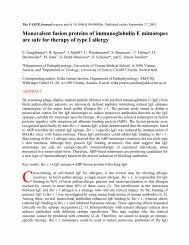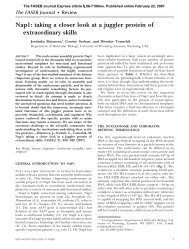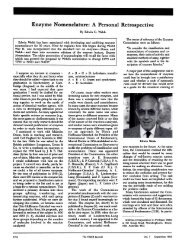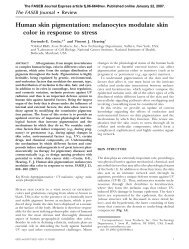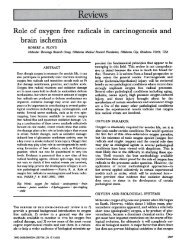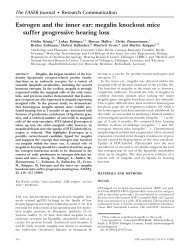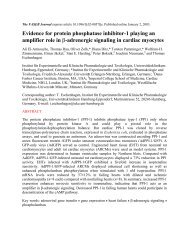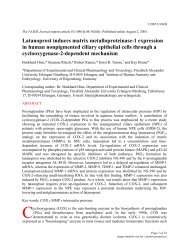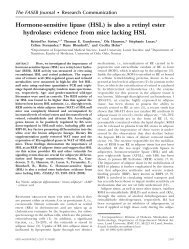Sense and Antisense in Biotech: The First Antisense DNA Company
Sense and Antisense in Biotech: The First Antisense DNA Company
Sense and Antisense in Biotech: The First Antisense DNA Company
You also want an ePaper? Increase the reach of your titles
YUMPU automatically turns print PDFs into web optimized ePapers that Google loves.
he could overlook Riordan’s nonmembership <strong>in</strong> the<br />
guild of molecular biology or among Mass General<br />
alumni. In any case, some prelim<strong>in</strong>ary communication<br />
between them went back <strong>and</strong> forth by facsimile (this<br />
was of course before e-mail), <strong>and</strong> then, one morn<strong>in</strong>g,<br />
Zamecnik walked <strong>in</strong>to my lab (upstairs over his) <strong>and</strong><br />
said that Riordan had launched his own antisense <strong>DNA</strong><br />
company. I was less surprised than Zamecnik, but<br />
noth<strong>in</strong>g I said could cool him down. I told him that<br />
although we had hoped we were be<strong>in</strong>g courted, it was<br />
equally possible that Riordan was check<strong>in</strong>g out the<br />
entire l<strong>and</strong>scape <strong>in</strong> a mission of self-designed due<br />
diligence. What Riordan had promptly understood was<br />
that although Zamecnik was the undisputed “father of<br />
the concept”, not Mass General, the Worcester Foundation,<br />
or Zamecnik himself was hold<strong>in</strong>g enabl<strong>in</strong>g<br />
patents (the Worcester Foundation’s granted Allowance<br />
of Claims did not reach <strong>in</strong>to the therapeutic<br />
doma<strong>in</strong>). Also, as I suspect, Riordan’s thoughts were<br />
that even if the Worcester Foundation might hold a<br />
patent soon, it could always be licensed <strong>in</strong>. From his<br />
perspective, why <strong>in</strong> the world would he want to fold <strong>in</strong><br />
an <strong>in</strong>ventor <strong>and</strong> his <strong>in</strong>stitution at the equity allocation<br />
<strong>and</strong> start-up phase? And, it is to be noted that Zamecnik<br />
had made it clear <strong>in</strong> the discussions that he wanted the<br />
Worcester Foundation to have an equity stake. I<br />
warmed to this, of course, but I could see Riordan<br />
<strong>in</strong>tegrat<strong>in</strong>g this <strong>in</strong>to his calculus. Moreover, I had<br />
sensed—just as a zephyr—that Riordan was not totally<br />
keen about Zamecnik’s choice of HIV as the first target.<br />
If so, there is great irony there, given what Riordan’s<br />
company ultimately went on to do <strong>in</strong> HIV therapeutics.<br />
In his f<strong>in</strong>al decision, Riordan chose to give up the<br />
prestige that Zamecnik’s name would have given to his<br />
company relative to the start-up dilution of equity that<br />
would have meant.<br />
Soon, Zamecnik <strong>and</strong> I became aware of pend<strong>in</strong>g<br />
relationships Riordan was negotiat<strong>in</strong>g as he sought to<br />
build his company. For example, there was oligodeoxynucleotide<br />
synthesis technology at Northwestern University<br />
(<strong>in</strong>vented by Robert Lets<strong>in</strong>ger) that Riordan was<br />
seek<strong>in</strong>g to license <strong>in</strong>. He had also, properly, looked <strong>in</strong>to<br />
work by Michael Gait at the Medical Research Council<br />
Laboratory at the University of Cambridge. Zamecnik<br />
was also pursu<strong>in</strong>g both Lets<strong>in</strong>ger <strong>and</strong> Gait, but Riordan<br />
had already signed them up. Meanwhile <strong>and</strong> <strong>in</strong> the<br />
opposite vector of contact <strong>and</strong> recruitment, another<br />
antisense start-up planner had tried to engage Zamecnik,<br />
but that is an entirely different story, perhaps for<br />
another time.<br />
HYBRIDON<br />
In 1990, 3 years after Riordan launched his company,<br />
Zamecnik <strong>and</strong> I cofounded Hybridon. I was a cofounder<br />
only by virtue of be<strong>in</strong>g president <strong>and</strong> scientific<br />
director of the Worcester Foundation, <strong>and</strong> simply represented<br />
the foundation’s equity stake. (I did not take<br />
founder’s stock <strong>and</strong> never owned stock after Hybridon<br />
SENSE AND ANTISENSE IN BIOTECH<br />
went public, believ<strong>in</strong>g that the company was not based<br />
on work from my lab <strong>and</strong> that I should therefore not<br />
personally ga<strong>in</strong> just because I happened to be president<br />
of the Worcester Foundation. I did receive an honorarium<br />
of $3000/year as a member of the Hybridon<br />
Scientific Advisory Board from 1990 to 1996 <strong>and</strong> felt<br />
this was acceptable, as my role there was as a RNA<br />
expert, not as the president of the Worcester Foundation.)<br />
Zamecnik immediately focused the company on HIV.<br />
His reason<strong>in</strong>g was that his “NIH tennis partner”, as he<br />
always described Robert Gallo after that Fogarty year at<br />
NIH, could help get National Institute of Allergy <strong>and</strong><br />
Infectious Disease contract fund<strong>in</strong>g for the antisense<br />
idea. Meanwhile, I worried that AIDS might be the<br />
wrong choice for an <strong>in</strong>itial proof of pr<strong>in</strong>ciple <strong>and</strong><br />
argued for a Hybridon project us<strong>in</strong>g antisense <strong>DNA</strong> <strong>in</strong><br />
the arena of hypertension to knock down the messenger<br />
RNA for the angiotens<strong>in</strong>-ren<strong>in</strong>-convert<strong>in</strong>g enzyme<br />
for treatment of essential hypertension. I had a long<br />
conversation with James Wyngaarden, then chairman<br />
of the Hybridon Scientific Advisory Board. Wyngaarden,<br />
formerly a colleague of Zamecnik at Mass<br />
General <strong>and</strong> later, director of NIH, was open to my<br />
idea, but after further discussion, we agreed that Hybridon’s<br />
cash position could not support a new project at<br />
the time. One th<strong>in</strong>g I learned (I learned so many th<strong>in</strong>gs<br />
<strong>in</strong> this biotech experience) is that it is very difficult—at<br />
least <strong>in</strong> a cash-strangled start-up (almost always so)—to<br />
change the R&D program.<br />
THE ANTISENSE PATENT LANDSCAPE<br />
<strong>The</strong> <strong>in</strong>tellectual property l<strong>and</strong>scape was murky <strong>in</strong> the<br />
early days of the antisense field, as it often is <strong>in</strong> any new<br />
technology. One of the enabl<strong>in</strong>g doctr<strong>in</strong>es <strong>in</strong> U.S.<br />
patent law—nonobviousness—seemed traversable <strong>in</strong><br />
the Worcester Foundation patent accord<strong>in</strong>g to some<br />
experts, but I worried about this go<strong>in</strong>g back to denatured<br />
<strong>DNA</strong>-RNA reanneal<strong>in</strong>g studies <strong>in</strong> the 1950s. And,<br />
<strong>in</strong> later years, complementary <strong>DNA</strong>s with base-pair<strong>in</strong>g<br />
recognition to targeted mRNAs were used to demonstrate<br />
the presence <strong>and</strong> abundance of these mRNAs <strong>in</strong><br />
cellular RNA <strong>in</strong> solution hybridization experiments <strong>and</strong><br />
also, to arrest the translation of a particular mRNA <strong>in</strong> a<br />
cell-free system. However, these publications (which I<br />
knew well from my own field of RNA science) never<br />
advanced or even h<strong>in</strong>ted at the idea of us<strong>in</strong>g a short<br />
<strong>DNA</strong> (or any other oligo) to <strong>in</strong>terrupt gene expression.<br />
Patent drama soon arose, as we all knew it would. <strong>The</strong><br />
aforementioned work at the NCI by Sam Broder <strong>and</strong><br />
Jack Cohen had resulted <strong>in</strong> a patent application on the<br />
use of antisense <strong>DNA</strong> to <strong>in</strong>hibit HIV, which was be<strong>in</strong>g<br />
pondered by the U.S. Patent <strong>and</strong> Trademark Office.<br />
Later, when Hybridon was deep <strong>in</strong>to its HIV program,<br />
NIH challenged the Worcester Foundation patent application<br />
relative to its own. Hybridon’s executive team<br />
<strong>and</strong> an attorney from its outside counsel flew to<br />
Bethesda, MD, on August 14, 1996. <strong>The</strong>y asked me to<br />
3599



